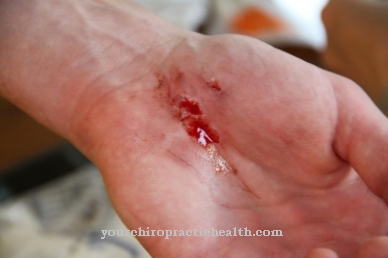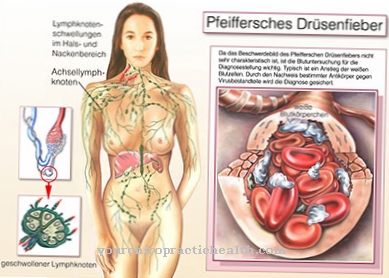A Mercury intoxication is a poisoning with mercury. A distinction can be made between acute and chronic mercury poisoning.
What is mercury intoxication?

© marcel - stock.adobe.com
The Mercury poisoning is also known as Mercurialism designated. It is caused by the direct ingestion of larger amounts of mercury or by the long-term ingestion of smaller amounts of mercury. Mercury is one of the toxic heavy metals. Symptoms range from headaches, nausea and dizziness to impaired vision or gait. Mercury poisoning is treated with an antidote. Cutler protocols are used in alternative medicine.
causes
Acute mercury intoxication is almost always the result of an accident. In the household, acute short-term poisoning with mercury can result from broken clinical thermometers or energy-saving lamps. However, studies have shown that short-term exposure is not a cause for concern. Fatal acute mercury poisoning is very rare.
In total there are only ten acute poisonings worldwide that have resulted in death. These were always occupational accidents in industry or research. Mercury is particularly toxic in organic compounds (e.g. as dimethylmercury). However, chronic mercury intoxication occurs much more frequently. The main cause here is the consumption of food that is contaminated with mercury.
An example of such a chronic intoxication is the Minamata disease. The disease was named after the Japanese city of Minamata, where thousands of people became chronically ill due to the consumption of contaminated seaweed and fish. Amalgam, a substance that is used in dentistry for fillings, is also suspected of causing chronic mercury poisoning. Other possible causes of chronic mercury poisoning are ingestion of the toxic substance at work or at home.
Symptoms, ailments & signs
The early symptoms of acute poisoning are nausea, dizziness, and headache. A dry mouth is also typical. An intake of 150 to 300 milligrams is fatal. Kidney or liver damage occurs long after the mercury is absorbed.
Chronic mercury intoxication often causes unspecific symptoms. The mercury is deposited in the teeth, in the spinal cord, in the internal organs, in the nerve tracts and in the brain. It is found in urine, blood, stool, and even breast milk. At first, those affected only suffer from fatigue and headache and body aches. Later on it comes to paralysis, unsteady gait, psychoses and in severe cases even a coma.
If left untreated, the disease is fatal. In pregnant women, the toxic substance reaches the unborn child via the umbilical cord. The affected children are born with various disabilities.
Diagnosis & course of disease
Various diagnostic methods are available if chronic mercury intoxication is suspected. The DMPS mobilization test can be used to detect mercury in the urine. DMPS forms a water-soluble complex with mercury. The heavy metal deposits in the organs should be mobilized and excreted as part of this test. The mercury concentration in urine is subject to fluctuations and deviations from time to time. Therefore, the urine is collected over 24 hours for determination.
The chewing gum test is used to determine the mercury content in saliva. This test requires chewing a sugar-free gum for ten minutes. The saliva that forms when chewing is collected and then examined in the laboratory. However, the exact mercury exposure cannot be diagnosed with this test. Rather, the test shows whether mercury is dissolving from existing amalgam fillings.
Mercury can also be detected in blood using various laboratory methods. The mercury content in the blood, however, is more of an indication of a recent exposure. In addition, mercury is also built into the hair roots. The mercury content in the hair is also a good measure for long-term exposure.
Complications
Mercury intoxication initially causes gingivitis, tooth loosening, diarrhea and kidney infections. These symptoms develop into serious complications in the course of the disease. Typical of a chronic course is damage to the nervous system, which can be associated with muscle twitching, mood swings, states of excitement and anxiety, and language or visual disorders. Personality changes and concentration disorders can also occur.
In general, the heavy metal damages the entire organism. In addition to the nervous system, the internal organs, the gastrointestinal tract and the skin are also often affected. Possible long-term consequences are irreparable kidney and liver damage as well as permanent ear, eye and nasopharynx diseases. If mercury poisoning is detected and treated early, these serious complications can be avoided. However, the treatment methods also involve risks.
Typically, antidotes such as dimercaptosuccinic acid and dimercaptopropane sulfonic acid are used - both associated with side effects such as dizziness, nausea and vomiting, fever and chills. Acetylcysteine and other drugs can also cause side effects and interactions. Intravenous treatment itself can lead to infection at the injection site. Edema or thrombosis, which in turn are associated with complications, rarely develop. After the treatment, there may be a relapse of the mercury intoxication.
When should you go to the doctor?
Mercury intoxication should always be treated by a doctor. Only through early diagnosis and treatment can further complications and, in the worst case, death be prevented. Self-healing does not occur in this disease, so that mercury intoxication should always be treated by a doctor. A doctor should be consulted if the person concerned has ingested an excessive amount of mercury. This leads to a very dry mouth and continuing to be very tired.
Paralysis or severe headaches can also indicate mercury intoxication and should be examined by a doctor. The affected person can also fall into a coma or show severe psychosis. If these symptoms occur after accidental ingestion, the hospital must be visited immediately or the emergency doctor must be called. As a rule, mercury intoxication can be treated relatively well if treatment is initiated early.
Therapy & Treatment
The mercury poisoning is treated with an antidote. So-called complexing agents are used for this. These are substances that form a metal complex with the mercury. These mercury-antidote complexes can be better filtered out of the blood by the kidneys. Substances such as dimercaptopropane sulfonic acid (DMPS) or dimercaptosuccinic acid (DMSA) are used.
If the intoxication was triggered by the ingestion of organic mercury poisoning such as methylmercury, acetylcysteine (NAC) is administered. In the past, minerals were also used to remove mercury. However, studies have shown that the effect is not sufficient. The so-called Cutler protocol is used in alternative medicine. The protocol also uses DMSA or DMPS. Alpha lipoic acid (ALA) is also used.
prevention
In order to prevent mercury intoxication, care should be taken when handling the toxic heavy metal. The indoor air hygiene commission of the German Federal Environment Agency has developed indoor air guide values for mercury. The guideline value II regulates the concentration of mercury, which must be acted upon immediately if it is exceeded. With reference value II, it is recommended to act quickly. Technical and structural measures may be necessary to reduce the concentration.
If clinical thermometers, barometers, blood pressure monitors or energy-saving lamps break in closed rooms, the air can be polluted with mercury vapors. The affected area should be well ventilated immediately. Adequate ventilation may be required for several weeks. Visible mercury globules should be carefully sucked up with a pipette and stored in a container under water until disposal.
If mercury spheres get into unreachable cracks or corners, they must be fixed with mercury absorbing agents. Since mercury vapor is heavier than air, it sinks. Small children and children who often play on the floor are therefore particularly at risk and should not play in mercury-contaminated rooms. Under no circumstances should the mercury be vacuumed up. The metal and the poisonous fumes are distributed over a wide area.
Aftercare
Following mercury intoxication, it is particularly important that the doctor's instructions are followed. Effective home remedies are not available for healing. Consistent use of the prescribed medication is therefore of crucial importance for rapid and sustainable treatment success.
Furthermore, patients can combat the accompanying symptoms of mercury intoxication. For example, in the case of severe itching, greasy or histamine-containing creams and ointments, which are available over the counter from pharmacies, help. If you don't get the itching under control, you can use special cotton gloves to prevent the skin from being scratched, especially in the night. Scratching causes injuries to the skin, which can subsequently lead to further diseases, including in particular secondary inflammation.
Many patients complain of gum problems following mercury intoxication. Here it is advisable to visit the dentist if specific symptoms appear. But even without acute symptoms, affected patients should pay attention to careful oral hygiene after a mercury intoxication. With antibacterial mouthwashes, dental floss and, if necessary, interdental brushes for the spaces between the teeth, inflammation of the gums can be effectively counteracted.
Finally, it is important to identify the source of the mercury intoxication. If the source of the poisoning has not been eliminated, other people should be warned to prevent further poisoning.
You can do that yourself
The attending physician has probably already prescribed chelation or other drainage therapy to remove the mercury. However, the patient himself can also do a number of things to remove toxic metal residues from his body. These include saunas, steam baths and sweaty exercise, because toxins are excreted with sweat. Foods rich in water such as fruit, tomatoes or asparagus also have a detoxifying effect. The person concerned should further support the detoxification process by not ingesting any other toxins. This primarily includes alcohol and nicotine, but also car exhaust fumes, fine dust and other air pollution. If these detoxification measures are not sufficient, many doctors recommend the so-called "Cutler Protocol" as an alternative. However, it is controversial and very time-consuming.
The mercury intoxication may have damaged the patient's oral mucosa. That makes meticulous oral and dental care indispensable. Dentists provide recommendations and assistance here.
If the mercury poisoning is more advanced, the physical consequences are treated symptomatically. These treatments can assist the patient with a healthy lifestyle. To avoid cachexia, he should eat enough even when it is difficult. The same applies to a regulated sleep-wake cycle. It should also be aimed for if the patient suffers from insomnia. Fixed rest periods, which must be observed, are helpful here.




.jpg)
.jpg)







.jpg)

.jpg)
.jpg)











.jpg)